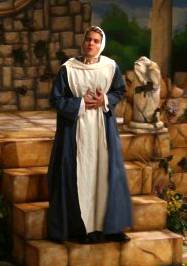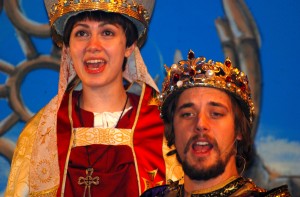NOT RECOMMENDED
Following their award-winning revival of Hair, producer Michael Butler and director/choreographer Bo Crowell return with the world premiere musical Pope Joan, the saga of history’s only female pope, who (supposedly) reigned for less than three years in the 850s.
Broadway smashes like Pippin have demonstrated that Medieval history can indeed make for exciting, involving musical theater, and the recent success of Spring Awakenings proves that, in the right hands, the past can be made as contemporary as the latest MTV rock videos. The talented cast performing Pope Joan on stage at the Stella Adler, the first-rate six-piece orchestra backing them up under the impeccable musical direction of Brian Murphy, and the stellar design team (made up of some of the best designers Los Angeles has to offer) are all as good as it gets. If the material they are working with here were anywhere near at their level, Pope Joan (with book, music, and lyrics by Christopher Moore) would be quite a show.
From Whitney Avalon’s sincere, passionate Joan (with a gorgeous soprano to match) to Doug Barry’s sexy, golden-voiced King Louis to the rest of the supporting cast (the company comprises 26 members in all), these are first-rate performers doing first-rate work. Brian Murphy proves again, as he did with Jesus’ Kid Brother (a “period musical” that works), that he’s is not only a whiz at the keyboard, he’s a terrific conductor as well. Shon LeBlanc’s 9th Century costumes run the gamut from royal garb to papal and cardinal robes to peasant wear and demonstrate once again that there is no better period designer than LeBlanc. Brent Mason’s imposing set appears almost to be made of massive gray Medieval stones and, lit by Jeremy Pivnick’s as always vivid lighting design, provides a great canvas for the tale. Sound designer Rebecca Kessin’s mix of miked singers and musical accompaniment could not be better. And the voices of the 18-member ensemble when joined in harmony are stunning, as in the opening number, “The Church Will Stand,” and the finale “A Thousand Years From Now. (Kudos to Randy Bowser’s musical arrangement.)
What is needed is a story to grab our interest, to make us care about the historical characters (the way we care about the Plantagenets in The Lion In Winter or the title character in Pippin) and storytelling that knows exactly what it is. As Pope Joan stands now, it is part Monty Python, part Les Miz, part Disney, part camp, part schoolbook serious, and part Red, White, and Blaine (which you may recall from Christopher Guest’s brilliant satire of community theater, Waiting For Guffman) That is to say that not all the laughs in Pope Joan are intentional.
In my review of 2007’s Hair revival, I praised the “verve and imagination” of Crowell’s direction and his “period perfect” choreography. The talented Crowell seems stumped by the awkward dialog and many tonal shifts in Pope Joan.
We first meet the titular Joan, who has lived her life up till now as “Brother John,” the morning after a sleep-over with her lover, King Louis. Louis’ friend (girlfriend? nurse? childhood babysitter?) Martine (Christina Dohmen) arrives with news. “The Pope in Rome is dead,” she informs the King, who decides to hightail it to the capital. “I’ve an empire to acquire,” he tells Joan and Martine. Louis, the great-grandson of Charlemagne (who coincidentally was Pippin’s father), has plans to become the Holy Roman Emperor and nothing or no one is going to stand in his way.
Meanwhile Cardinal Nicholas (Anthony Gruppuso) and assorted Cardinals perform “A Sad And Tragic History”, a sort of synchopated rock ballad complete with a blend of finger snaps, jive hands (a la Grease) and shimmies that would not be out of place in Spamalot. (Composer Moore does have a gift for melody and rhythm, though the over 2½ hour show could easily lose about a quarter of its songs.)
In a flashback, we see Young Joan (Allie Costa) singing in her sweet, innocent voice about God when a burly villager is killed with a single blow. “Be cured,” she warbles, and miracle of miracles, he is. You’d think the villagers would be grateful, but no, “She’s a sorceress!” they shout, and even the peasant whose life she saved wants her burned at the stake. Apparently, mistreatment by these unappreciative locals convinces Joan that she’d be better off sequestered from the hoi polloi, hence her decision to become Brother John.
 A cute young polyglot named Lucius (Bryce Blue), whose blue robe and white apron and bonnet make the androgynous lad look an awful lot like Sally Field’s Sister Bertrille (only without her winged Flying Nun wimple), joins Joan’s entourage. “I’ve gone on many great adventures with Homer and Virgil,” the book-loving twink tells Joan, but he dreams of being “Outside These Walls.” (Think “Out There” from Disney’s The Hunchback Of Notre Dame, minus the gypsy Esmeralda, or Ariel’s “Part Of Your World.”)
A cute young polyglot named Lucius (Bryce Blue), whose blue robe and white apron and bonnet make the androgynous lad look an awful lot like Sally Field’s Sister Bertrille (only without her winged Flying Nun wimple), joins Joan’s entourage. “I’ve gone on many great adventures with Homer and Virgil,” the book-loving twink tells Joan, but he dreams of being “Outside These Walls.” (Think “Out There” from Disney’s The Hunchback Of Notre Dame, minus the gypsy Esmeralda, or Ariel’s “Part Of Your World.”)
In Rome, the townspeople tout their wares in the catchy “The Forum In Rome,” a number which once again features the ensemble in fine form, jumping and spinning about and singing in melodious harmony until a little boy drops dead. Joan aka Brother John once again performs a miracle, and the Romans prove they are no kinder or more enlightened than the folks in Joan’s hometown, for they too turn on the “evil sorceress.” (My guest was prompted to comment, “You’d think Joan would have learned the first time.”)
Pope Anastasius (Fernando Orozco, Jr.) wonders if the boy’s healing was indeed a miracle and decides that Brother John is much too important to ignore. How, he asks himself, might he enlist Brother John’s support for his goals? Altruistic Joan entreats Anastasius to help the poor of Rome in “Another Rome.” “This must be our mission,” she tells him. “They’re calling out to you and me.” (If she thinks Anastasius is going to agree to help the rabble, she’s got another thing coming.)
Martine, meanwhile, is good and pissed off. For twenty years, she has served this “viper” of King, and she still has no child to show for it, not even a foundling she could adopt. (She ought to hook up with Lucius, who wonders if there’s something he could do with his “seed,” so that “it won’t be wasted.”)
Louis, however, has more important things to think about than Martine. He needs Joan’s help in persuading Anastasius to give him the Imperial crown–either that, or kill the Pope. And Joan, who still has the hots for Louis, wonders why her “body and soul are so at war with each other.”
Will Louis become the Holy Roman Emperor? Will Joan see the connection between her sexual relationship with Louis and the child she has conceived? (Originally, she’d been overjoyed that her pesky monthly visitor had stopped coming, which illustrates that sex education was every bit as needed in the 9th Century as it is now.) How many of Pope Joan’s lead characters will survive to final curtain?
These questions are answered in Pope Joan’s second act, which (no spoiler) does indeed see Brother John fulfill his/her destiny as the title character, albeit briefly.
Avalon, Barry, Dohmen, Gruppuso, Blue, Orozco, Costa, and Suzanne Nichols as Lucretia (who belts out the Prologue and reappears from time to time to narrate) are all absolutely terrific performers, and there’s not a weak voice among them. The ensemble (Amber Allen, Justin Beals, Tim Brown, Megan Crockett, Don Frankel, Brandon Heitkamp, Matthew Herrmann, Sylvin Janson, James Lamberti, Annette Remter, Erin Rettino, Joel Rieck, A. Torres-Salazar, Veronica Scheyving, Heather Stewart, Paul Wong, Dawn Worral, and Joseph Zahn) are so all-around excellent that one wishes they they were performing material of matching quality.
If there is a musical in the story/legend of Pope Joan, it is not this puzzling, overly long adaptation of her life. As it stands, though, Pope Joan does at least offer playgoers a chance to see and hear some very talented performers both onstage and in the orchestra pit.
Stella Adler Theatre, 6773 Hollywood Blvd, Hollywood.
www.plays411.com/popejoan
–Steven Stanley
January 29, 2009
Photos: Melinda McLeod




 Since 2007, Steven Stanley's StageSceneLA.com has spotlighted the best in Southern California theater via reviews, interviews, and its annual StageSceneLA Scenies.
Since 2007, Steven Stanley's StageSceneLA.com has spotlighted the best in Southern California theater via reviews, interviews, and its annual StageSceneLA Scenies.







 COPYRIGHT 2025 STEVEN STANLEY :: DESIGN BY
COPYRIGHT 2025 STEVEN STANLEY :: DESIGN BY